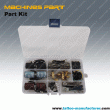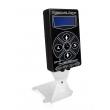Modern tattoo machines in use: here outfitted with a 5-needle setup, but number of needles depends on size and shading desired.
Tattooing involves the placement of pigment into the skin's dermis, the layer of dermal tissue underlying the epidermis. After initial injection, pigment is dispersed throughout a homogenized damaged layer down through the epidermis and upper dermis, in both of which the presence of foreign material activates the immune system's phagocytes to engulf the pigment particles. As healing proceeds, the damaged epidermis flakes away (eliminating surface pigment) while deeper in the skin granulation tissue forms, which is later converted to connective tissue by collagen growth. This mends the upper dermis, where pigment remains trapped within fibroblasts, ultimately concentrating in a layer just below the dermis/epidermis boundary. Its presence there is stable, but in the long term (decades) the pigment tends to migrate deeper into the dermis, accounting for the degraded detail of old tattoos.
Some tribal cultures traditionally created tattoos by cutting designs into the skin and rubbing the resulting wound with ink, ashes or other agents; some cultures continue this practice, which may be an adjunct to scarification. Some cultures create tattooed marks by hand-tapping the ink into the skin using sharpened sticks or animal bones (made like needles) with clay formed disks or, in modern times, needles. Traditional Japanese tattoos (Horimono) are still "hand-poked," that is, the ink is inserted beneath the skin using non-electrical, hand-made and hand held tools with needles of sharpened bamboo or steel. This method is known as tebori.








